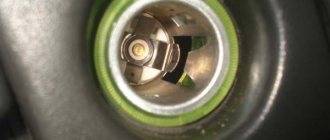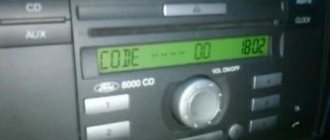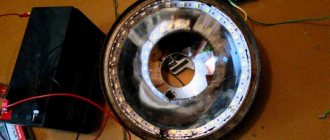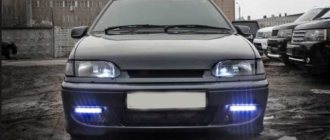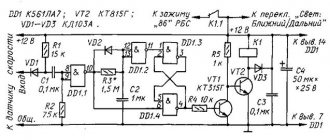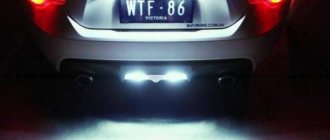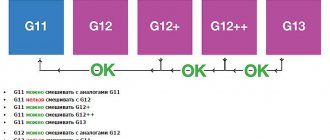When twilight falls, in heavy fog or snow, the car is difficult to see, and its size is not easy to determine. For safety, side lights are provided - additional lighting devices that indicate the dimensions of the car.
Dear readers! The article talks about typical ways to resolve legal issues, but each case is individual. If you want to find out how to solve your particular problem , contact a consultant:
+7 (499) 938-81-90 (Moscow)
+7 (812) 467-32-77 (Saint Petersburg)
8 (800) 301-79-36 (Regions)
APPLICATIONS AND CALLS ARE ACCEPTED 24/7 and 7 days a week.
It's fast and FREE !
The obligation of drivers to use side lights in certain situations is determined by the Rules of the Road - clause 19.3. An administrative fine is provided for ignoring the use of light signals.
American type parking (marker) lights
In the United States, most parking lights have been used in conjunction with turn signals (turn signals) for a long time. As a rule, cars for the American market use double-helix lamps inside the turn signals, one of which lights up constantly when the lights are on, and the other lights up when the turn signals are turned on. In this case, the side lamps begin to blink in a brighter color.
The side lights turned on on cars from the USA look especially interesting in the photographs.
White marker lamps as part of a separate lamp
This type of parking lights is more familiar in our country as many older cars are equipped with this type of parking lights. The thing is that this type of parking lights was often used until recently in European, Asian and Russian cars.
This type of size is a separate lamp installed in a transparent lamp (lantern). According to GOST, side lights must be installed on both sides of the vehicle in pairs on the same line.
LEDs or halogens
Side marker lights Halogen bulbs are often used for side marker lights, but today manufacturers are increasingly using LED bulbs for car side marker lights. This choice is based on the functionality of the LEDs. LED side lights last much longer (up to 100,000 hours), the brightness of such bulbs is better, they consume less electricity, they are resistant to temperature fluctuations, vibration, and incorrect operation. Despite the increased cost of LEDs, their characteristics completely cover this disadvantage and quickly pay for themselves. The main thing, no matter what lights you choose for the parking lights, remember - they should not burn brighter than the brake lights.
Side parking lights
There is another type of side lights that were installed on old cars of the 80s and early 90s (mainly Japanese cars). We are talking about white side parking lights that turned on on the side of the intended turn or lane change when parking.
By the way, unlike the flashing turn signals, the white side lights were constantly on when parking.
Old style parking lights
Some older domestic vehicles used another type of parking lights. For example, starting in 1968, Moskvich-408 cars received side parking lights installed on the rear body pillars. These lights were turned on by a special toggle switch in the car's interior. Later, Moskvich abandoned this type of parking lights.
Today, such parking lights are usually installed on buses, trucks and other special equipment.
Traffic rules
The first to include the mandatory use of headlights in traffic regulations were the United States. The changes came into force in the 68th year of the last century. At the same time, such a resolution appeared in Canadian legislation. If the driver ignored these instructions, he was subject to a fine.
Moreover, these instructions applied to any type of mechanical device. Since the introduction of these changes, the number of accidents on the road has decreased by almost half.
If the car is stopped on the side of the road in the dark, be sure to leave the lights on. The rules do not prohibit the use of additional light, such as running lights. The main thing is that the car is clearly visible to other road users.
Side light color
As for the front dimensions, they should always be white. The rear ones are basically red. As for the side ones, the driver can use yellow, orange or blue light bulbs. Such strict restrictions are not the whim of law enforcement agencies. It’s just that the inconsistency in the car’s lighting confuses other road users. Especially if the driver “tunes” the front optics and installs red lights in them.
Fines
Although the details of the use of side lights are not strictly regulated in many rules (there is no separate fine for each violation), the driver may receive a warning or a receipt for payment for violating the rules in the following situations:
- The car is standing on the side of the road in the dark, there are passengers sitting in it, but the dimensions are not illuminated;
- The headlights are so dirty that their glow is hard to see;
- Driving in poor visibility only on clearance.
Some may regard strict rules in the use of car lighting as an infringement on self-expression. In fact, this is done solely for the sake of traffic safety.
Side lights inside the main headlight
Another type of installation of parking lights. True, it is also less common. For example, similar parking lights were found in Volkswagen Beetles, Nissan Pao and Porsche 356. With this design, the parking lamps are installed inside the main headlights.
But such use of dimensions is ineffective, since the marker lamp inside the headlight produces a very dim glow.
Advantages and disadvantages of lighting devices
Thanks to the presence of dimensional LED lamps, every motorist can easily indicate the dimensions of his own vehicle, as well as warn other road users that you are about to stop or make any maneuver. It is acceptable to use them as brake lights and parking lights. So, giving preference to LED headlights, you should count on the main advantages:
- compact dimensions with wide possibilities for tuning;
- ease of installation and operation (elementary replacement);
- more light than halogen and xenon bulbs;
- maximum efficiency and minimum fuel consumption;
- long service life, even without heating;
- reliable tightness (resistance to moisture);
- ability to flare up at full power after switching on.
So, what are side lights for?
As you probably already guessed, parking lamps are designed for... parking. That is, you should use your side lights when you park your car.
Don't believe me? Then you seem to have forgotten paragraph 19.3 of the Rules of the Road:
- 19.3 Traffic rules of the Russian Federation: When stopping and parking at night on unlit sections of roads, as well as in conditions of insufficient visibility, the side lights on the vehicle must be turned on . In conditions of poor visibility, low-beam headlights, fog lights and rear fog lights can be turned on in addition to the side lights.
Also, don't forget that parking/marker/parking lights came out in an era when the world's street lighting still left much to be desired. In those days, in the evening, the streets of even large cities were very dark. As a result, in those years, motorists, as a rule, parked their cars in dark, narrow streets.
In order for a car standing on the road to be visible to all drivers passing by, front and rear marker lights were invented. By the way, parking lights, as a rule, are not bright, but dim. This is done intentionally so that the parking lights do not drain the car's battery while parked. So the dimensions consume little energy due to their low power.
No, of course, side lights can easily drain a new battery to zero. But to do this, you must leave your car in the parking lot for a day (more or less depending on the make, model of the car and battery capacity).
See also: Inattentive drivers face new fines - Parking for electric vehicles in Moscow
By the way, there is even a persistent myth that car enthusiasts have been telling each other for a long time about the fact that side lights greatly drain the battery. That is why a large number of car owners, having parked their car on the road for a while, do not turn on the lights for fear of draining the battery.
Moreover, often people, saving energy in the battery, do not turn on the side lights even where it is dangerous. For example, parking a car on the side of the road on a dark highway. But this not only violates the current Traffic Rules, but also increases the risk of getting into an accident. After all, drivers of other cars may not notice you. So why violate it when the dimensions when parking the car temporarily will not drain the battery? Agree, there is no point. Therefore, always turn on your headlights at night when you park your car. Remember that they are not useless.
Fortunately, in many modern cars, the side lights (if they are not present, the daytime running lights are turned on) turn on automatically when the key is turned in the ignition.
But nevertheless, some even new cars still have a separate button for turning on the side lights. In this case, do not forget to include them where necessary. Especially when driving out on the road at night.
Why use the function of automatically turning on the headlights and parking lights in your car?
The ANV high beam control system is becoming increasingly popular among car owners. Recently, it has become mandatory for installation for vehicles with a permissible maximum weight of up to 3.5 tons. Its main function is to switch headlights from high beam to low beam and back in automatic mode.
It was created primarily for safer driving at night. And, I must say, it copes with its task excellently. Visibility is significantly improved, and the light of your car does not blind oncoming people. In addition, the driver is freed from the need to be distracted from the road, constantly changing the operating modes of the headlights.
In addition, in accordance with Russian legislation, driving during daylight hours with low beam or fog lights on is mandatory. Violation may result in a fine, so you must constantly ensure that your headlights are on correctly.
At the same time, light assist is not free from shortcomings. And first of all, it does not work correctly in the off-season, in particular in the fall. And it has arrived not only on the calendar. Fog, frost, rain – road users constantly encounter these atmospheric conditions that are uncomfortable for driving.
And it is precisely in such weather that the ANV system does not function correctly, or rather, it is not activated and does not work. This is due to a fundamental flaw in its design. As already mentioned, it works without problems in low light, in the dark.
Here's how it's implemented, say, in Toyota cars: (video)
This happens because the car has a light sensor. It is also called a twilight or light sensor. It consists of a photocell, a control unit and a relay. When a car enters a low-light area, say a tunnel, the system automatically turns on the high beams without distracting the driver.
However, the aforementioned signs, which are so characteristic of the Russian off-season, such as fog, snow or rain, do not affect the level of illumination. But the automatic lighting system does not define them as a change between light and dark or day and night. And as a result, despite the dangerously poor visibility, we are still driving with daytime running lights.
This shortcoming of the high beam control system has been known for a long time. However, drivers have already become accustomed to its convenience and sometimes forget about possible tricks on its part in certain weather conditions.
But such forgetfulness can be costly. And not only for you. What does it mean - the road is poorly lit, visibility has deteriorated, the lights don’t light up? Answer: you are not just invisible on the road. You simply do not exist for other road users. And when your presence is finally discovered, the consequences of such a “find” can be unpredictable. It's good if it's just a fine. What if there is an accident?
Therefore, we strongly recommend that car owners whose cars are equipped with light assist do not rely on the tricks of technology, but use common sense: visibility has become worse, air transparency has decreased - turn on the low beam.
And we turn it on ourselves, by hand. And it’s a good idea to add fog lights to it.
Tail lights
Tail lights used on cars in Russia can only be red. The use of markers of a different color is prohibited.
Typically, tail lights are installed as part of a single tail light unit. According to current legislation and traffic regulations of the Russian Federation, trucks and buses must also be equipped with additional side lights indicating the size of the vehicle.
As a rule, in all cars the rear marker lights turn on together with the front lights. To do this, either use a separate button located in the cabin, or the lights are turned on automatically after turning the key in the ignition (automatic turn on of the lights is used in many modern cars).
Additional vehicle lighting symbols
Additional light markings for the body are required for trucks, since they are large, and in the dark it is necessary to accurately mark all the outer parts of the vehicle. By default, such vehicles must have the same lighting devices as passenger cars. Additionally, illumination of the side parts of the entire car is installed.
When installing such lighting, it is important that the bulbs do not differ in either brightness or color. The side lights of trucks must only be yellow or orange. Blue bulbs can be installed, but only as side markers.
An important condition when using additional illumination of dimensions is symmetrical installation. When using such lighting fixtures, you should purchase lamps made by the same manufacturer. Only if these two factors are observed can you be sure that large vehicles will be correctly marked at night. According to documents, some cars belong to the category of passenger transport; their dimensions are quite large. In such cases, owners of such vehicles install additional lights on the roof of the car. In addition to the fact that it looks beautiful, drivers of oncoming traffic can recognize the dimensions of the car. The main thing is that such lighting does not blind other road users.
Is there liability for side lights that are not turned on?
Yes and no. The thing is that there is no separate liability for side lights that are not turned on in Russian legislation. There is only general article 12.20 of the Code of Administrative Offenses of the Russian Federation, which prescribes the responsibility of drivers for violating the rules for using external lighting devices , sound signals, hazard warning lights or warning triangles. Let us repeat that, according to Article 12.20 of the Code of Administrative Offenses of the Russian Federation, the driver faces a fine of 500 rubles.
Accordingly, if the driver does not turn on the side lights when stopping and parking the car in the dark on an unlit road, then he may be brought to administrative liability by traffic police officers. For example, if you stopped on the side of the road at night and did not turn on your side lights, you may be subject to administrative liability.
How to fix the problem yourself
Below you will find information about liability if there is something wrong with the dimensions. To avoid it, you need to learn how to change the light bulb yourself.
If the clearance lamp begins to blink or burns out, it must be replaced with a working one. There can be two problems: the light bulb or fuse has burned out.
The replacement issue is solved simply and is accessible even to a beginner:
- You need to open the hood.
- Remove the cover from the back of the headlight.
- Unscrew the base.
- Replace the light bulb.
The fuses are located under the steering wheel on the right. The vehicle's operating manual must contain information about which fuse belongs to the size.
These simple manipulations will help you save 500 rubles in your budget, and most importantly, avoid troubles. One of the things that makes a car noticeable in the dark is its dimensions.
In what other cases do you need to turn on the side lights?
Drivers must turn on their side lights not only when stopping or parking their car at night. Also, side lights should be turned on when visibility is insufficient. For example, during the day and at night during snowfall, rain, fog, etc. Including in cloudy weather. Naturally, in conditions of insufficient visibility, in addition to the side lights, you should turn on low beam headlights, front and rear fog lights (if necessary).
Device
The marker lamp can be non-separable or collapsible; consists of three parts:
- housings;
- diffuser;
- lamps.
In modern cars, halogen or LED bulbs are installed in the side lights. When choosing, you need to remember that the rear lights should not be brighter than those of the brake lights or turn indicators.
The best option is LEDs and LED blocks. They consume less energy than halogen or incandescent lamps, and their service life is longer.
LED lamps are resistant to temperature changes, vibration and incorrect use.
To use an LED lamp, it must be included in the design of the vehicle. Otherwise, the fault sensor will light up, and measures will have to be taken to stabilize the voltage.
The fact is that the power of LEDs is lower than halogen bulbs. The luminous intensity of the dimensions ranges from 4 to 100 candelas.
Most often, the side lights turn on automatically: simultaneously with the low beam headlights.
Some cars have the ability to use dimensions separately. This feature can be useful for marking the boundaries of a car, for example in a busy parking lot.
On cargo transport, reflectors are often installed as clearances. Reflectors reflect light from other cars. In the group of light signaling devices, they are considered a passive means of lighting.
All marker lights must be of the same brand and manufactured by the same manufacturer.
The dimensions must match:
- the power of light;
- angle of light propagation;
- lamp type;
- brightness.
When purchasing dimensions, it is important to make sure that there are markings indicating the nominal values: power and voltage, as well as a clear manufacturer’s mark.
What is the maximum speed allowed in the yard according to traffic regulations is described in the article: Traffic regulations in yards. Read about the fine for tinting in 2022 according to traffic rules here.
What are the responsibilities for installing blue (or other color) marker lamps?
In accordance with the current legislation, established provisions of GOST, as well as in accordance with the requirements for the approval of vehicles for operation, for the use of red marker lamps in the front part (instead of white), as well as other colors (green, red, etc.), liability is provided for Part 3 of Article 12.5 of the Code of Administrative Offenses of the Russian Federation. Here is the text of the law:
- Part 3 of Article 12.5 of the Code of Administrative Offenses of the Russian Federation “Driving a vehicle on the front of which are installed lighting devices with red lights or red reflective devices, as well as lighting devices, the color of the lights and the operating mode of which do not comply with the requirements of the Basic Provisions for the Admission of Vehicles to Operation and responsibilities of officials to ensure road safety
- entails deprivation of the right to drive vehicles for a period of 6 months to 1 year with confiscation of the specified devices and accessories.”
In the rear, the side lights should be red. Accordingly, the use of lamps of a different color is also prohibited.
See also: On October 14, 2022, traffic police changes to the rules for issuing driver’s licenses will come into force
So, as you can see, despite the advent of daytime running lights, which have begun to replace classic side lamps in the front end, the era of parking lights is not over yet. At least in the rear of all cars, classic marker lamps installed in the taillights are still used.
The thing is that side lights are very necessary. After all, they help motorists see other cars on the road.
Driving during daylight hours
In good visibility
When driving during daylight hours, the vehicle must have one of the following lights on:
- low beam;
- Daytime Running Lights;
- fog lights;
If the car has all the listed devices, then it makes sense to use DRL. These lights are brighter and use less electricity.
When driving, the following can also be turned on:
- parking lights.
It is prohibited to use:
- fog lamp.
In case of insufficient visibility
One of the following lighting fixtures must be used:
- low beam headlights;
- high beam headlights.
In this case, the main beam cannot be used:
- in populated areas on illuminated roads;
- when oncoming vehicles pass;
- when blinding drivers of passing or oncoming cars.
Additionally, the car may include:
- fog lights;
- fog lamp;
- parking lights;
- Daytime Running Lights.
Note. The rear fog light is specifically designed for use in conditions of poor visibility, but in practice no more than 10 percent of drivers use it. The rest, apparently, do not know the relevant rules.


